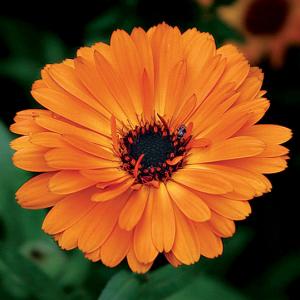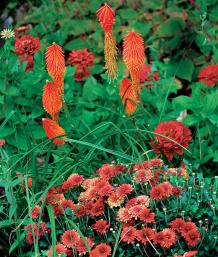
Photo/Illustration: Michelle Gervais
Orange is a color with undeniable pizzazz. Made from red and yellow, orange gets its sizzle from red and its carrying power from yellow. On the value scale, only yellow is lighter and, therefore, more visible from a distance. But yellow lacks the ripe warmth of orange, which is unique in being the only secondary hue made from two warm primaries; every other color has a warm version and a cool version.
Indeed, warmth is the stock in trade of the orange family and its most winning attribute in the garden. Orange’s range is limited somewhat because, like yellow, orange is essentially a light, bright color. There are no truly dark shades of yellow and precious few dark shades of orange. Depth belongs to the reds, greens, blues, and violets. But for luscious, fruity tints— persimmon, cantaloupe, and mango—look to the orange family.

If you’re looking for pure orange, look no further than this calendula.
Photo/Illustration: Steve Aitken

Impatiens (Impatiens walleriana cvs.) provide a range of delicious, fruity orange tints that brighten shady gardens.
Photo/Illustration: Steve Aitken
In the garden, orange is a better team player than either of its parents. As individual colors, red and yellow have nothing in common. Thus, one of the best uses of orange is to tie these two colors together in mellow accord.
To see how these three hues work together, imagine a midsummer garden of glorious, warm, marmalade colors: masses of daylilies (Hemerocallis cvs.) in red, red-orange, orange, yellow-orange, and yellow; Golden Splendor trumpet lilies (Lilium Golden Splendor Group); black-eyed Susans (Rudbeckia fulgida var. sullivantii ‘Goldsturm’); and false sun-flowers (Heliopsis helianthoides cvs.). Heat up the mix with a clump or two of scarlet ‘Lucifer’ crocosmia (Crocosmia ‘Lucifer’). If you want contrast, green foliage will provide all that you need.
The Orange Family
The orange hues below are named according to their proportions of red and yellow. Familiarity with these colors may inspire you to depart from the tradition of cool pink schemes and try warm salmon-pinks and orange tints.
For a bold garden scene, put industrial-strength orange with an equally strong blue, and stand back. As nature makes sparing use of saturated, true blue, you might want to employ some paint. An obelisk, a chair, even a watering can may be painted blue and placed among orange flowers, such as good old marigolds (Tagetes spp. and cvs.) or calendulas (Calendula officinalis cvs.). Every autumn in the Northeast, nature flaunts this complementary duo on a grand scale: the orange leaves of a maple (Acer spp. and cvs.) against a blue sky, a testament to the brilliant impact of orange.

The easiest way to describe a color is by illustrating that hue with a flower. Nothing elucidates the color orange more definitively than the California poppy (Eschscholzia californica).
Photo/Illustration: Colleen Fitzpatrick

Set off by green, red-hot pokers (Kniphofia cv.) are a rich but mellow tint that gives off warmth and light. Maturing flowers among red-orange mums add touches of yellow-orange, illustrating how well this color family works together.
Photo/Illustration: Jennifer Benner
Photos, except where noted: Melissa Lucas

















Comments
Log in or create an account to post a comment.
Sign up Log in